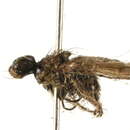Comprehensive Description
provided by Smithsonian Contributions to Zoology
Notiphila (Dichaeta) pallidipalpis Cresson
Notiphila pallidipalpis Cresson, 1940:8.
Notiphila (Agrolimna) pallidipalpis.—Cresson, 1946:223.
TYPE-MATERIAL.—Holotype male: “Isle Royale Mich(igan). Aug. 3–7, 1936, C. Sabrosky/TYPE 6544 Male Notiphila PALLIDIPALPIS, E. T. Cresson, Jr.” The holotype is deposited with the Academy of Natural Sciences of Philadelphia, type number 6544. The following paratypes were also designated by Cresson: 2 , Leelanau County, Michigan, 21 June 1937; 1 , Beaver Dam, Wisconsin, 2 July 1915; 1 , Moore's Lake, Anoka County, Minnesota, 19 June 1925; 1 , Lake Calhoun, Hennepin County, Minnesota, 12 June 1921, 1 and 1 , Orillia, Ontario, Canada, 17 July 1923, 1 , Uhthoff Ontario, Canada, 14 July 1923.
DIAGNOSIS.—Specimens of N. pallidipalpis may be distinguished from those of all other species of the subgenus Dichaeta by the following combination of characters: Antennal segments entirely black; maxillary palpus pale, yellowish orange; mesonotum and mesopleuron immaculate; all tarsi pale, although front tarsomeres often slightly darker; setal fascicle of hind basitarsus pale; fascia of abdominal terga blackish brown with well-defined posterior margins. Characters of the terminalia of N. pallidipalpis males bear closest resemblance to those of N. sicca and N. deserta. The aedeagal apodemes of N. deserta and N. pallidipalpis males are especially similar and the hypandrial processes of both also closely resemble each other. However, differences are shown in Figures 171–172.
DESCRIPTION.—Medium-sized to moderately large shore flies, length 3.25 to 4.45 mm; with brownish gray to olive gray coloration and dark blackish brown markings.
Head: Head ratio 1:0.75; postfrons ratio 1:0.55; frons with median triangular area and lateral margins generally concolorous, however, the lateral margins are often lighter; remainder of frons darker brown with some blackish tinges, pollinose. Para-vertical bristle larger than postocellar setae, subequal to genal bristle; 2 pair of proclinate, fronto-orbital setae. Antenna entirely black; arista with 8–12 dorsal branches. Face pale, grayish yellow; prefrons ratio 1:0.62; facial setae hairlike. Eye ratio 1:0.72; eye-to-cheek ratio 1:0.185; gena concolorous with face anteriorly, becoming gray posteriorly; genal bristle as above. Maxillary palpus pale, mostly orange.
Thorax: Dorsum slightly darker than pleural areas, grayish brown to gray; mesonotum and mesopleuron immaculate. Femora and tibiae black with some gray dusted areas; front tarsomeres usually yellow but often with some darker areas; middle and hind tarsi yellow; setal fascicle of hind basitarsus pale. Wing ratio 1:0.41; costal vein ratio 1:0.53; M1+2 vein ratio 1:1.
Abdomen: Abdomen ratio of males 1:0.78; length of fourth tergum to fifth tergum ratio of males 1:1.12; fifth tergum ratio of males 1:0.67. Fascia dark brown with posterior edge distinct; fifth tergum mostly dark brown. Male terminalia as in diagnosis and Figures 171–172.
SPECIMENS EXAMINED (149).—CANADA: MANITOBA: Teulon (CNC); Wabowden (CNC). NEW BRUNSWICK: Cahmcook, Glebe Road (CNC). NOVA SCOTIA: Lockeport (CNC). ONTARIO: Britannia (CNC); Mer Bleue (ANSP, CNC); Norway Point, Lake of Bays (CNC); Orillia (ANSP); Uhthoff (ANSP). QUEBEC: Hull (CNC); Knowlton (CNC); Wakefield (CNC). SASKATCHEWAN: Waskesiu Lake (CNC); Waskesiu River (USNM); White Fox (CNC). UNITED STATES: IDAHO: Kootenai Co., 0.8 km E Harrison (WNM). IOWA: Hamilton Co., Goose Lake (USNM); Story Co., Ames (CNC); Wright Co., Little Wall Lake (USNM). MICHIGAN: Cheboygan Co. (KU, MSU, USNM), Mackinac City (ANSP); Crawford Co. (USNM); Iosco Co. (MSU); Iron Co., (USNM); Keweenaw Co., (USNM), Copper Harbor (ANSP); Leelanau Co. (USNM); Muskegon Co. (USNM); Grand Traverse Co. (USNM); Wexford Co. (USNM). MINNESOTA: Anoka Co., Moore's Lake (ANSP); Cook Co., Grand Marais (ANSP); Hennepin Co., Lake Calhoun (ANSP); Lake Co., Basswood Lake (UMN); Ramsey Co., Saint Anthony Park (UMN). MONTANA: Lake Co., 3.2 km W Bigfork (KSU), 3.7 km E Bigfork (WNM), 1.6 km S Swan Lake (WNM), 4 km S Swan Lake (WNM), 32.2 km S Swan Lake (KSU). NEW HAMPSHIRE: Lost River (ANSP); Crawford Notch (USNM); Lakes of the Clouds (CNC); Franconia Notch (ANSP, USNM); Grafton Co., Stinson Lake, White Mts. (MCZ, USNM). NEW YORK: Oswego Co., Saint Marys Pond (CU); Tompkins Co., Dryden Lake Outlet (CU); Wayne Co., Sodus Pt. (ANSP).
GEOGRAPHIC DISTRIBUTION (Figure 173).—The occurrence of N. pallidipalpis is apparently restricted to northern United States and southern Canada. Collection dates are from 3 June to 7 October.
- bibliographic citation
- Mathis, Wayne Neilsen. 1979. "Studies of Notiphilinae (Diptera: Ephydridae), I: Revision of the Neartic Species of Notiphila Fallen, Excluding the Caudata Group." Smithsonian Contributions to Zoology. 1-111. https://doi.org/10.5479/si.00810282.287

